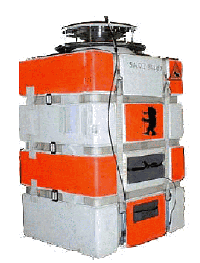Purpose of the flight and payload description
SAOZ stands for Systeme d'Analyse par Observation Zenithale and is a UV-visible spectrometer able to provide vertical profiles of O3, NO2, OClO, BrO and H2O by solar occultation during ascent of the balloon (or descent) and from float at 30 km during sunset (or sunrise). The balloon version of the SAOZ instrument is very similar to the one used for ground-based measurements of total ozone and NO2.
It is composed by a commercial flat field, 360mm, holographic grating spectrometer equipped with a 1024-diode linear array and an entrance slit of 50 µm. A simple conical mirror replaces the gondola orientation or sun tracker systems generally used on large balloon platforms and is driven by an on-board computer, connected to a PTU (Pressure, Temperature and Humidity) sensor, a GPS (Global Positioning system ) for the localisation (Altitude, latitude and longitude) and an Argos transmitter for the recovery of the payload after cut-down and descent under parachute.
At left can be seen a picture of the standard package.The weight of the instrument is 20 Kg and is contained in a insulated box with only a small aperture in the top for capture the solar rays. It's currently flown in three configurations, SaOZ-Standard, SAOZ-BrO and SAOZ-H2O each tuned to a different wavelength for measurements of different atmospheric constituents.
DIRAC which stands for Determination In situ by Rapid Analytical Chromatography. is a portable, lightweight gas chromatograph aimed to perform fast analysis of a single tracer to maximize the vertical resolution of ascent/descent profiles. It was developed by the University of Cambridge based on the techniques used in another instrument called DESCARTES. The sample in DIRAC is collected on a Carboxen trap by passing through it a known volume of air. The use of the carbon based Carboxen adsorbent enables a wide range of halocarbons to be pre-concentrated prior to analysis, thus extending the potential range of measured species. DIRAC has a maximum autonomy of 10 hours and works automatically using a PC-104 embedded computer. Data is stored on board and can also be transmitted to ground via a telemetry link. It's overall weight is 21 kg.
µLIDAR also known as MULID is the first lightweight balloon-borne microlidar ever built. It was developed by CNR-ENEA to measure the depolarized signal backscattered by cloud particles. It's light source is a solid state laser of 1.5 µJoules of power that operates at a repetition rate of 1 kHz and at a wavelength of 532 nm. The receiver is composed by a Newtonian modified reflector telescope and the detectors are two photo-multipliers modules used to collect the backscattered light and to divide it according to its wavelength. The whole system (weighting 4 kg) is enclosed in an insulating polyurethane shield to reduce heat exchange with external environment and externally covered by a reflecting Mylar microfilm. The gondola final weight including batteries and balloon control systems is of 10 kg.
The Surface Acoustic Wave (SAW) H2O sensor is a frost point hygrometer developed by the University
of Cambridge that uses a surface acoustic wave (SAW) crystal instead of the classic cooled mirror and
optical detector. The SAW crystal is placed, together with an accurate platinum resistance thermometer, onto
a Peltier cooler. When cooled to the frost point, water vapour condenses onto the SAW surface, reducing the
SAW oscillation frequency and amplitude, forming the basis of a feedback circuit. The temperature at which
condensation occurs is then related to the ambient water vapour amount.
The Solid State Ozone Sensor (SSS O3) developed by the University of Cambridge consists of a thin tungsten oxide layer mounted on a small ceramic tile. When is heated to its operating temperature, oxygen vacancies, formed thermally at the oxide surface, create electron donor states, resulting in an increase
in charge carrier concentration. Ozone molecules react filling the oxygen vacancies, thus decreasing the charge carrier concentration. Measuring the change in electrical resistance, lead to infer in a few seconds the ozone concentration. Its weight is less than 0.5 kg, excluding batteries.
Details of the balloon flight
Balloon launched on: 2/23/2003 at 20:20
Launch site: Meteorological Research Institute, Baurú, Sao Paulo, Brazil
Balloon launched by: Centre National d'Etudes Spatiales (CNES) / GLB
Balloon manufacturer/size/composition: Zero Pressure Balloon model 10zl 10.000 m3
End of flight (L for landing time, W for last contact, otherwise termination time): 2/23/2003
External references
- Balloonborne lidar for cloud physics studies Applied Optics Vol. 45, Issue 22, pp. 5701-5708 (2006)
- Balloon-borne stratospheric BrO measurements: comparison with Envisat/SCIAMACHY BrO limb profiles Atmos. Chem. Phys., 6, 2483-2501, 2006
- HIBISCUS campaign web site Laboratoire Atmosphères, Milieux, Observations Spatiales LATMOS
- Optical measurements of atmospheric particles from airborne platforms: in situ and remote sensing instruments for balloons and aircrafts ANNALS OF GEOPHYSICS, VOL. 49, N. 1, February 2006
- Overview of SCIAMACHY validation: 2002-2004 Atmos. Chem. Phys., 6, 127-148, 2006
- SAOZ balloon profiles for the validation of OSIRIS, SCIAMACHY and GOMOS at various latitudes 17th ESA Symposium on European Rocket and Balloon Programmes and Related Research, 30 May - 2 June 2005, Sandefjord, Norway
- The Validation of the Envisat Chemistry Instruments by Use of Stratospheric Balloons and Aircraft ENVISAT Validation Workshop (ESA SP-531). 9-13 December, Frascati, Italy
224If you consider this website interesting or useful, you can help me to keep it up and running with a small donation to cover the operational costs. Just the equivalent of the price of a cup of coffee helps a lot.


